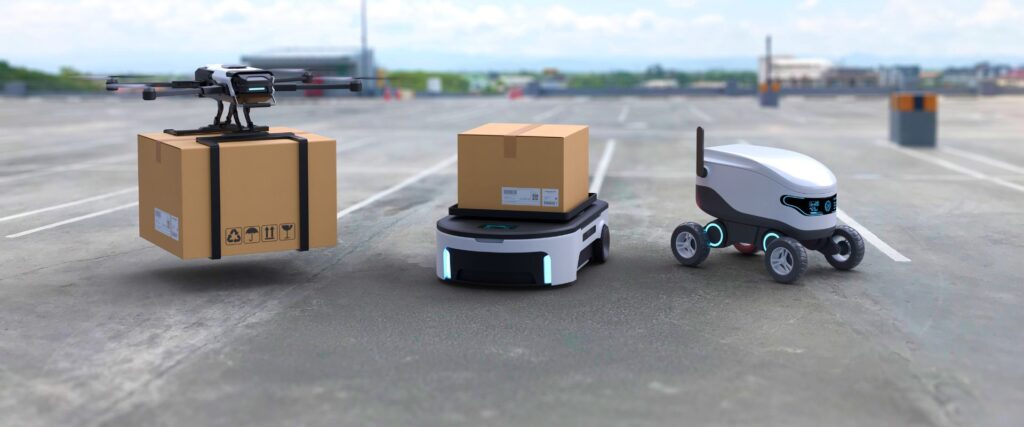Navigating the Last Mile: How Technology is Paving the Way for Efficient Delivery Systems

Last-mile delivery plays a crucial role in logistics and supply chain management, directly impacting customer satisfaction and retention. Despite its importance, traditional last-mile delivery systems often fail because of several challenges such as operational delays, inefficiencies, and high costs. This blog post explores how technology is transforming last-mile delivery, enabling businesses to overcome these obstacles and provide a seamless customer experience.
Emerging technologies in support of last-mile delivery
A. Drones and autonomous vehicles
- Benefits and applications: Drones and autonomous vehicles have the potential to revolutionise last-mile delivery by reducing human intervention, decreasing delivery times, and minimising costs. They can navigate difficult terrains and reach remote locations, making them an attractive option for delivery services in urban and rural areas.
- Current use cases and future prospects: Several companies, including Amazon and UPS, are experimenting with drone delivery services. Regulatory bodies, such as the Federal Aviation Administration (FAA) in the United States, are also working on establishing guidelines for drone operations. The adoption of autonomous vehicles for last-mile delivery is expected to increase over the next few years as technology advances and regulations adapt.
B. Robotics and automated delivery systems
- Different types of robotic solutions: From sidewalk delivery robots to warehouse automation, robotic solutions are becoming increasingly popular in last-mile logistics. They can perform repetitive tasks with speed and accuracy, leading to increased efficiency and reduced errors.
- Advantages and limitations: Robots can operate 24/7 and are not subject to fatigue or human error, improving overall productivity. However, they may require significant upfront investment and can be limited by infrastructure or terrain constraints.
- Real-world examples: Companies like Starship Technologies and Nuro have developed autonomous delivery robots that can navigate sidewalks and roads to deliver parcels to customers. Retail giants like Amazon and Walmart are also leveraging warehouse automation and robotics to streamline their last-mile delivery processes.
C. Advanced route optimisation and navigation tools
- GPS tracking and real-time data integration: GPS-enabled tracking devices provide real-time location information, allowing logistics companies to optimise routes and reduce delivery times. Integrating real-time data from traffic, weather, and other sources can further enhance route planning.
- Machine learning and artificial intelligence for route planning: AI and machine learning algorithms can analyse historical and real-time data to predict optimal routes, taking into account various factors such as traffic, road conditions, and delivery priorities.
- Success stories and future potential: Logistics companies like UPS and FedEx have successfully implemented advanced route optimisation tools, resulting in significant cost savings and improved efficiency. As AI and machine learning continue evolving with every passing day, route optimisation technology is expected to become even more sophisticated and accurate.
The impact of logistics technology on customer experience
A. Faster delivery times and improved efficiency: The adoption of innovative technologies in last-mile delivery space allows businesses to provide faster and more reliable services, meeting the growing consumer demand for prompt deliveries.
B. Enhanced visibility and tracking capabilities: Real-time tracking and data integration enable customers to monitor their packages throughout the entire delivery process, increasing transparency and trust.
C. Personalised delivery options and increased flexibility: Technology-driven solutions offer customers more control over their delivery preferences, such as scheduling deliveries or choosing alternative pick-up points.
D. The role of technology in reducing environmental Impact: Efficient route planning and the use of electric or autonomous vehicles can help reduce fuel consumption and carbon emissions, contributing to a more sustainable logistics industry.
The Future of Last-Mile Delivery: A Look Ahead
A. The role of emerging technologies in shaping the future of last-mile delivery: As technology continues to progress, new logistics software solutions will emerge that further enhance last-mile delivery efficiency, sustainability, and customer satisfaction.
B. The importance of collaboration between logistics companies and technology providers: Successful implementation of last-mile delivery technologies will require close collaboration between various stakeholders. This includes the development of supportive regulations and the fostering of innovative partnerships between technology providers and logistics companies.
C. Potential impact on employment and workforce dynamics: As technology-driven solutions become more prevalent in last-mile delivery, the role of human workers may shift. Companies will need to prioritise workforce training and development to ensure employees can adapt to changing job requirements.
D. Embracing innovation to stay ahead in the competitive logistics landscape: Companies that invest wisely in innovative last-mile delivery solutions and adapt to evolving customer demands will be well-positioned to succeed in an increasingly competitive market.
The integration of technology in last-mile delivery has the potential to transform the logistics industry, addressing longstanding challenges and providing an excellent customer experience. By embracing and investing in innovative solutions, businesses can unlock the full potential of last-mile delivery, creating a more efficient, sustainable, and customer-centric logistics landscape.
If you are in the logistics business and want your business to have a cutting-edge technological advantage, get in touch with us and let’s discuss how we can upgrade your business.
